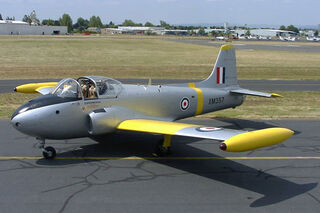
The BAC Jet Provost was a British jet-powered trainer aircraft used by the Royal Air Force from 1955 to 1993. The Jet Provost was also succesfully exported, serving in many airforces worldwide.
Design and development[]
In the 1950s the RAF issued a requirement for a new dedicated jet training aircraft. Hunting Percival developed the Jet Provost from the piston-engined Percival Provost basic trainer. On 26 June 1954, the prototype XD674 made its first flight from the factory at Luton Airport, flown by Dick Wheldon. The Air Ministry ordered ten of the Jet Provost T1. The prototype Jet Provost T.1 with the initial longer undercarriage at the Farnborough Air Show in 1954
In June 1957, an order was placed for the first 40 of the developed Jet Provost T3, featuring a more powerful Armstrong Siddeley Viper jet engine, ejector seats, a redesign of the airframe, and a shortened and strengthened version of the retractable tricycle undercarriage. Percival built one example used purely for structural tests throughout the development stages, giving the designers valuable research into what could be achieved with the basic design. In total, 201 T3s were delivered between 1958 and 1962.
The T4 followed in 1961, fitted with a new Viper engine, and this was followed by the pressurised T5 in 1967.
The T51 was an armed export version, sold to Ceylon (Sri Lanka), Kuwait and Sudan. It was armed with two 7.7-mm (0.303-inch) machine guns. The T52 was another export version sold to Iraq, South Yemen, Sudan and Venezuela, with the same armament as the T51. The T55 was the final armed export version which was sold to Sudan.
A more heavily armed variant of the airframe was developed as the BAC Strikemaster.
Operational service[]
The Jet Provost proved to be a capable trainer. After successful acceptance trials of the T1 during late 1955 at No. 2 Flying Training School at RAF Hullavington, the RAF formally accepted the type in 1957. The first production version was the T3, powered by the Viper 102, and this entered service with No. 2 FTS, now relocated to RAF Syerston, during June 1959, when deliveries commenced from the Hunting Aircraft factory at Luton airport.
The later T4 was fitted with the more powerful Viper A.S.V. 11 of 2,500 lbs static thrust and first flew on 15 July 1960. It quickly entered service with several Flying Training Schools including No. 1, No. 2, No. 3 and No. 6.
The T5 variant was further developed and fitted with the Viper 201 and cockpit pressurisation. These developments encouraged the RAF to utilise the Jet Provost in a number of different roles besides basic training. With a top speed of 440 mph, excellent maneuverability, mechanical reliability and low operating costs, the Jet Provost was utilized as an aerobatic aircraft, air warfare and tactical weapons training as well as advanced training. The first T5 made its maiden flight on 28 February 1967 and deliveries from BAC's Warton factory commenced on 3 September 1969. Operators of the T 5 included the RAFs Central Flying School and No. 1, No. 3 and No. 6 Flying Training Schools.
Besides service with the RAF, the Jet Provost found success in export markets. Jet Provosts were withdrawn from RAF service in the early 1990s and replaced by Short Tucanos. The Jet Provost remains popular among enthusiasts and being an inexpensive jet, many are now in private hands. Some are flown at airshows.

